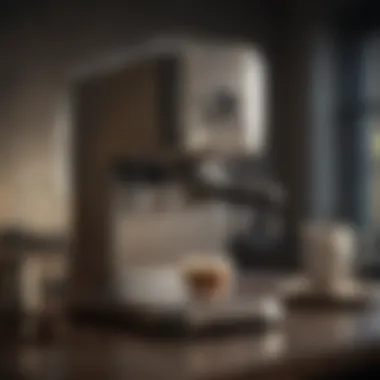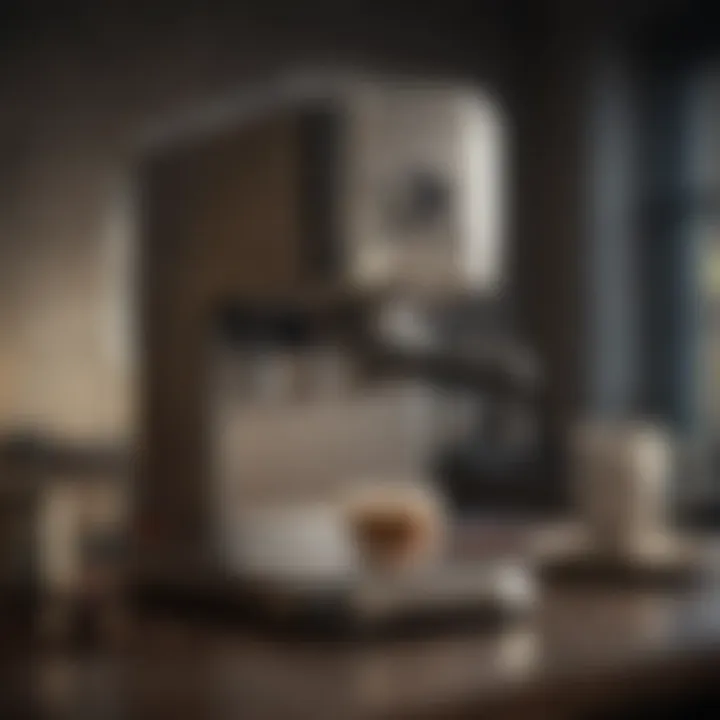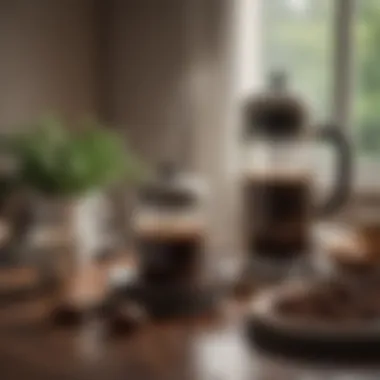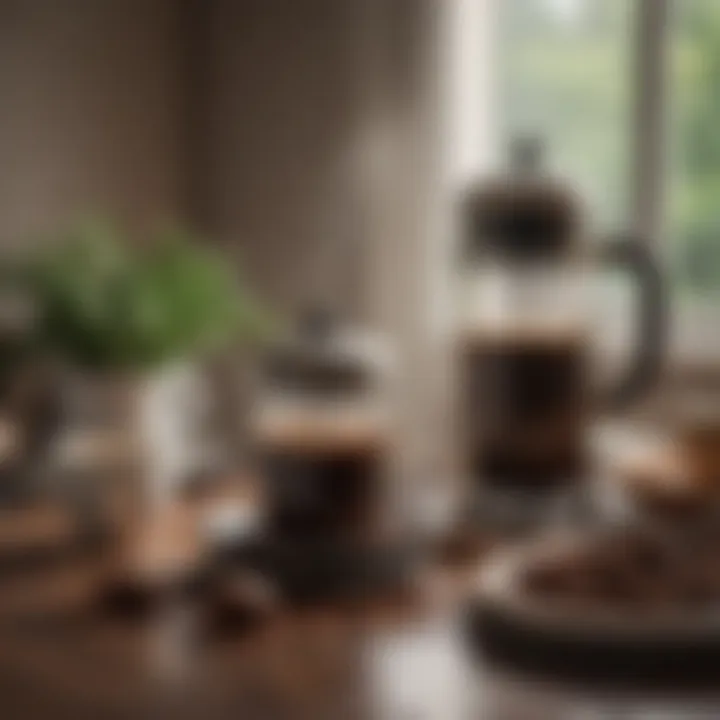Exploring the French Coffee Maker: Brewing Mastery


Intro
The French coffee maker, also known as the French press or press pot, is a cherished brewing device that has stood the test of time, enduring the relentless march of modern technology. Unlike its counterparts, it offers a method of brewing coffee that connects individuals to the very essence of the drink, wrapping them in a sensory experience that begins with the grind of beans and culminates in the first sip.
This article delves into the delicate interplay of design, functionality, and tradition embodied by the French coffee maker. Not only do we explore its historical roots, but we also examine its intricacies, unveiling how it's not merely a kitchen gadget but an art form in its own right.
By the end of this journey, readers will glean valuable insights—understanding the mechanics of brewing with this classic method, the distinct flavors it can produce, and the best practices for perfecting their brew. For homeowners and design enthusiasts alike, the French coffee maker isn't just a tool; it's a centerpiece that can enhance the aesthetic appeal of any kitchen, ushering in an elegant blend of form and function.
Prelude
The French coffee maker, often recognized for its elegance and simplicity, represents more than just a brewing device; it symbolizes a profound relationship between a culture and its love for coffee. In this article, we aim to dissect the many layers of the French coffee maker, looking not just at its functionality, but also at the artistry and tradition that surround it. Understanding this brewing method is crucial for anyone who seeks to refine their coffee experience.
Brewing coffee with a French coffee maker isn’t merely about consuming caffeine. It’s about the ritual of preparation, the intimacy of choosing quality beans, and achieving the perfect balance of flavors. Each step plays a pivotal role in elevating this daily chore into a cherished moment. Homeowners, interior design enthusiasts, party hosts, and gardening aficionados alike can find joy in integrating this process into their routines, enhancing both their social gatherings and personal time.
As we delve deeper into this guide, we'll look at how the French coffee maker became a cornerstone of coffee culture. Readers will learn about its historical significance, explore the intricate mechanics involved, and engage with practical tips for optimizing their brewing technique. This knowledge serves not just to create incredible coffee but also enhances your overall appreciation for a craft that many take for granted.
"A good cup of coffee can change your day, a great one can change your life."
Through this exploration, we will cover essential elements, including:
- The rich history that led to the rise of this iconic brewing method.
- The vital components that make up the French coffee maker.
- The brewing process that allows users to unlock unique flavor profiles.
- How to seamlessly integrate this brewing method into your daily routines.
This journey ultimately holds significance not just for coffee aficionados, but for all who appreciate a well-crafted experience.
History of the French Coffee Maker
The history of the French coffee maker is not just a tale of a brewing device but a reflection of cultural evolution, technological innovation, and culinary passion that has shaped coffee drinking into a cherished ritual. This section delves into the roots of this iconic brewing method, highlighting its significance in the coffee world. Understanding its history allows enthusiasts and casual drinkers alike to appreciate the artistry behind the brew, revealing layers of flavor, tradition, and personal expression. Not only does this exploration offer insight into the mechanics of coffee itself, but it also demonstrates how such a humble device can become a centerpiece in homes and cafes worldwide.
Origins in France
The inception of the French coffee maker can be traced back to the early 19th century when coffee drinking was becoming increasingly popular in France. The catalyst was the introduction of a new method to brew coffee that diverged from the boiling methods traditionally used. The French press, as we know it today, is said to have emerged in Milan around 1929, but the foundational ideas were already present in earlier designs.
It started with a simple concept: steeping ground coffee in hot water, then separating the grounds from the brew. This was revolutionary. Imagine a time when coffee was merely boiled. This new approach allowed for a richer, fuller flavor profile to bloom—and this style quickly took root across France. Coffee houses began to spring up, offering patrons not just coffee, but an experience that combined relaxation and social interaction.
In France, coffee became more than just a beverage; it transformed into a social symbol. Whether among intellectuals discussing ideas in a café or simply friends gathering around a table, the French coffee maker played a pivotal role. This device holds the essence of French culture, mirroring the country’s artistic and culinary legacies. As such, it’s no surprise that one will still find cafés keeping the charming yet functional French press in the spotlight, firmly cementing its status in the realm of coffee culture.
Evolution of Design
Over the years, the design of the French coffee maker has undergone several transformations. Early models might seem rudimentary to us today, often crafted from glass and metal with simple pusher devices. However, the beauty of the French press lies in its simplicity. This uncomplicated design allows for a direct interaction with the brewing process, giving one ownership of the final taste.
As time went on, designers from various regions began to introduce improvements and variations. Glass, stainless steel, and even ceramics began to feature as materials, leading to a diversity of styles. Modern options may include double-walled designs that offer better insulation, which helps maintain optimal temperature during brewing. Each evolution reflects not only an advancement in technology but also changes in consumer preferences and technological capabilities.
Many contemporary French coffee makers maintain the principle of immersion but add flair with ergonomic handles, varied sizes, and even artistic silhouettes. This balance between tradition and contemporary needs illustrates a significant aspect of the French coffee maker’s journey—the blend of old world charm with modern innovation in a bid to cater to the evolving coffee lover.
"The glory of the coffee press lies not merely in its function but in creating a moment to savor every sip, connecting us to a historical legacy of coffee enjoyment."
In summary, exploring the history of the French coffee maker reveals a rich tapestry intertwined with France's evolving coffee culture. Its origins highlight a moment when coffee transcended mere consumption to become a social cornerstone, while the evolution of design tells a story of refinement—a continual quest to enhance the coffee experience.
Components of the French Coffee Maker
When it comes to brewing a cup of coffee, the components of the French coffee maker play a vital role in not only the process but also the final product. Understanding these components sets the stage for a rich and flavorful coffee experience, enabling coffee enthusiasts to connect with their brew on a deeper level. Each part has its own function, contributing to the overall performance of the French press, making it essential to appreciate their individual importance.
Materials Used
The materials that comprise the French coffee maker significantly impact both durability and brewing quality. Typically, the main components include:
- Borosilicate Glass: This is often used for the carafe due to its resistance to thermal shock. It’s not only practical but also allows you to see the coffee as it brews, adding to the visual appeal of the process.
- Stainless Steel: Frequently employed for the plunger and filter, stainless steel offers strength and longevity. Many users appreciate how it resists corrosion while supporting the aesthetic of a sleek design.
- Plastic Components: Some models incorporate BPA-free plastic for handles and lids. While lighter and cheaper, the choice of plastic can sometimes affect the overall temperature retention compared to glass or stainless-steel counterparts.
In recent years, more brands have emerged, experimenting with trendy materials like wood or copper to elevate the design aspect. For instance, a lovely wooden handle can lend a warm, rustic feel to the coffee maker, appealing to homeowners wanting to create a cozy kitchen atmosphere.
Understanding the Plunger Mechanism
At the heart of a French coffee maker lies the plunger mechanism, which is responsible for separating the brewed coffee from the ground beans. This process is not just functional; it’s an art that enhances the brewing experience. Let’s break down its components:
- Plunger Handle: Designed for easy operation, a firm grip on the handle leads to better control when pressing down. A well-designed handle aligns with ergonomic principles, ensuring comfort during use.
- Filter Screen: A crucial part that needs mentioning, the filter screen prevents coffee grounds from entering the cup. Typically made of fine mesh stainless steel, it’s designed to capture even the tiniest particles, allowing flavorful oils to seep through while keeping the sludge at bay.
- Pressure Mechanism: When you press the plunger down, you are applying pressure that forces hot water through the coffee grounds. This process extracts essential oils, flavors, and aromas, contributing directly to the taste of your brew. A well-constructed plunger will create a consistent pressure that leads to an even extraction.
The elegance of the plunger mechanism lies in its simplicity. With no electronic parts, the French coffee maker appeals to traditionalists who appreciate craftsmanship over machinery. This blend of materials and functionality is key in providing not just coffee, but an experience that resonates with lovers of fine design and great tastes.
"The beauty of the French press lies in its ability to transform simple elements into a delightful brew, bridging the gap between simplicity and sophistication."
In summary, the careful selection of materials and an understanding of the plunger mechanism are both critical for anyone aiming to master the art of brewing with a French coffee maker. By paying attention to these components, coffee lovers can elevate their coffee game to new heights, finding joy in every cup.


Brewing Process
The brewing process sits at the heart of what makes the French coffee maker a beloved appliance among coffee enthusiasts. Unlike other methods that may prioritize speed or convenience, brewing coffee with a French press is an art form where patience and precision play pivotal roles. It's not just about making a cup of coffee; it's about cultivating an experience, transforming simple ingredients into a delightful beverage that speaks to the senses.
When approaching coffee brewing, the quality of the beans, the proper grind size, and the control of brewing variables such as water temperature and steeping time are all essential. Each of these elements contributes significantly to the flavor, aroma, and overall satisfaction derived from the coffee, making the brewing process a crucial topic of discussion.
Selecting Coffee Beans
Choosing the right coffee beans is akin to selecting the best ingredients for a dish. The first step in achieving the perfect brew involves understanding the diversity within coffee beans.
Types of Coffee Beans
One can choose from various types of coffee beans, notably Arabica and Robusta. Arabica beans are typically characterized by their smooth taste and sweet undertones, making them a popularly preferred choice among coffee connoisseurs. The flavor profile can often reveal floral or fruity notes, which is essential for a nuanced cup of coffee. On the other hand, Robusta beans present a stronger, harsher flavor with higher caffeine content; some find this advantageous, particularly in espresso blends.
The unique feature of these beans lies in their growing conditions: Arabica is generally cultivated at higher altitudes, adding complexity, while Robusta flourishes in harsher climates, leading to a more earthy taste. Opting for Arabica for your French press could lead to a more enjoyable and sophisticated beverage, suited for leisurely mornings, while Robusta may suit those craving stronger coffee kicks.
Grind Size
Equally important in the selection of beans is the grind size. In a French press, a coarser grind is often recommended to avoid over-extraction, which can turn the coffee bitter. A medium-coarse grind allows for the optimal extraction of flavors while ensuring manageable filtration through the metal mesh. Finer grinds, although illustrative of other brewing methods, could lead to a gritty texture and less pleasant drinking experience.
Identifying the right grind size is crucial; too fine, and the brew might become undesirable, while too coarse could under-extract the beans. Finding that ideal balance can profoundly influence the richness of your cup.
Water Temperature and Quality
The temperature and quality of the water used in brewing can't be overlooked. Water that's too hot can scald the coffee, accentuating undesirable flavors, while water that's too cold will fail to extract the essential oils and flavors. Ideally, water should be heated to about 200°F (93°C) before adding to your grounds. Investing in well-filtered water is also beneficial; impurities can alter the flavors of your coffee, ruining the experience.
Step-by-Step Brewing Guide
Bringing all these elements together into a coherent brewing process can yield exceptional results. Here are some step-by-step instructions:
- Select your coffee beans: Choose between Arabica for a lighter brew or Robusta for something stronger.
- Measure your coffee: A common ratio is 1:15 coffee to water; that is, one ounce of coffee for every 15 ounces of water.
- Grind your coffee: Opt for a coarser grind to maintain a balanced extraction.
- Heat your water: Aim for about 200°F to prevent scalding.
- Combine coffee and water: Pour the hot water over the grounds in the French press.
- Stir gently: Allow the coffee to bloom for a minute before stirring.
- Steep: Let it steep for about four minutes, but feel free to adjust based on taste preference.
- Press down the plunger: After steeping, gently press down to filter the coffee.
- Pour and enjoy: Serve immediately for the freshest taste.
"A well-brewed cup of coffee is an invitation to savor life’s moments, however ordinary they may seem."
By paying attention to the nuances of your brewing process, you'll find that using a French coffee maker can elevate your daily rituals into a ceremonious experience that goes beyond just caffeine—it's about cultivating a passion for quality.
Flavor Profiles
Understanding the flavor profiles produced by the French coffee maker can greatly enhance the brewing experience. Each cup of coffee made using this method carries nuances that contribute to its unique taste. From the aromatic richness to the full-bodied essence, the French press brewing method is particularly known for delivering a strong and robust flavor. This article delves into how varying brewing times and techniques lead to diversity in flavor, underscoring the art behind this iconic brewing style.
Impact of Brewing Time
The brewing time is crucial when it comes to extracting flavors in coffee. With a French press, the typical brewing time ranges from four to five minutes. However, this can vary based on personal preference and the type of coffee bean used.
- Shorter brews (2-3 minutes) can yield a lighter flavor that highlights the acidity of the beans, possibly bringing out fruity and floral notes.
- Longer brews (6-7 minutes) will lead to a darker, richer coffee with pronounced earthy and bitter flavors. But, beware! Extending the brewing time too much can also result in over-extraction, causing a harsh taste.
Finding that sweet spot in the middle can unlock a beautifully balanced cup, emphasizing both body and complexity.
Comparative Tasting Notes
In tasting, it’s essential to recognize the differences among brewing methods. Each technique provides its own signature profile, which is particularly noticeable in the comparison between the French press and other popular methods.
French Press vs. Other Methods
When examining the French press against other brewing techniques like drip brewing or espresso, a few characteristics come to light. The French press is known for its immersion technique which allows coffee grounds to steep in water longer without filters absorbing oils.
- Key Characteristic: This immersiveness leads to a full-bodied flavor due to the essential oils and sediment remaining in the brew.
- Why It's Beneficial: It offers a richer, more nuanced taste compared to drip methods which might filter out these oils, resulting in a possibly thinner cup.
In contrast, espresso machines rely on pressure to extract flavor quickly. While espresso can create a concentrated form of coffee, it often lacks the subtlety of a French press brew.
Advantages of the French Press:
- Simplicity of design
- No electricity needed
- Full control over steeping time
Drawbacks:
- May require more cleanup due to grounds left in the pot
- Might be more tedious for making larger quantities
Maintenance and Care
The joy of brewing coffee with a French coffee maker is unmissable, yet it demands an equally attentive upkeep. Keeping this apparatus in pristine condition not only prolongs its life but also ensures a consistently delightful cup. The art of coffee brewing involves various steps, but maintenance and care are often brushed aside. Engagement in proper care leads to optimal flavor extraction and prevents unwelcome bitterness in your brew. Here, we delve into specific areas to focus on that can make all the difference in your coffee experience.


Cleaning Your French Coffee Maker
Cleaning your French coffee maker should be a ritual, not a chore. Over time, oils from coffee can accumulate, leading to rancid flavors that tarnish your otherwise rich brew. The cleaning process isn’t overly cumbersome, which is a relief for many coffee enthusiasts. Here’s how to do it:
- Disassemble the Maker: Remove the plunger and filter from the carafe.
- Wash With Warm Soapy Water: Use a gentle dish soap and a soft sponge. Avoid abrasive materials that can scratch the glass.
- Rinse Thoroughly: It’s crucial to rinse all soapy residue away to prevent any lingering tastes.
- Dry Completely: Let the components air dry or use a clean cloth to wipe away moisture.
- Deep Cleaning Once a Month: Consider running a mixture of equal parts water and white vinegar through the maker and then rinsing with water to eliminate any hidden grime.
Keeping your French press clean not only maintains the flavor but enhances the health standards of your beverage.
Common Issues and Solutions
Every coffee aficionado encounters hiccups along the way. Being aware of common issues with French coffee makers can simplify solutions and prevent brewing disasters. Here are some frequent problems:
- Grainy Texture in Coffee: This issue usually arises from an improper grind size. If your grind is too coarse, grounds may slip through the filter. Solution? Opt for a medium grind to achieve clarity in your brew.
- Overly Bitter Coffee: This often results from over-extraction or prolonged brewing time. If you notice bitterness, try reducing the steeping to just four minutes.
- The Plunger Sticks: Sometimes, the plunger may not budge. This could be due to grounds getting trapped. A gentle wiggle, or ensuring the grounds remain at the bottom can remedy this.
- Cracked Carafe: A mere misstep can lead to a cracked carafe. Regularly inspect your pot for signs of wear. If damage occurs, replace it promptly to avoid glass shards in your brew.
In entrenching these practices of care, your French coffee maker turns into not just an appliance, but an ally in the daily ritual of coffee enjoyment.
Incorporating the French Coffee Maker into Daily Routines
The practice of brewing coffee using a French coffee maker can easily transition from an occasional treat to a daily ritual. This section explores how to seamlessly integrate this brewing method into your everyday life, making it not only a pleasure but also a practical part of your daily routine. From creating a dedicated coffee space to understanding how it pairs with breakfast and snacks, these elements underline the richness and enjoyment of coffee culture.
Setting Up a Coffee Station
Creating a dedicated coffee station can serve as the nerve center for your brewing routine. When well-set, this setup transforms the mundane act of making coffee into an art form, offering a moment of calm amid the bustle of everyday life.
- Location Matters: Find a suitable area in your kitchen or nook with access to water and power. A corner countertop or a small table can suffice, as long as it has good light and enough space for your French coffee maker and essentials.
- Organize Your Space: Keep coffee beans, grinder, and other necessary tools within arm's reach. Consider using decorative jars for beans, giving a nod to aesthetics alongside functionality.
- Incorporate Accessories: Having quality tools at hand can elevate the experience. Include a burr grinder for a consistent grind, measuring spoons, and a beautiful kettle for boiling water. Each element contributes to the overall joy of the brewing process.
- Aesthetic Touches: Add personal touches like coffee-themed art or small plants to your station. These finishing touches make the space inviting, turning it into a warm haven during your busy mornings.
Pairing with Breakfast and Snacks
A well-brewed cup of coffee pairs wonderfully with a variety of breakfast options and snacks, enhancing both the flavors of the food and the enjoyment of your coffee experience.
- Breakfast: Consider enjoying your coffee with buttery croissants or fresh baguettes, traditional staples that embody French culinary culture. The flaky pastry complements the rich flavors of a full-bodied coffee brewed in a French press.
- Snacks: Maybe you’re after something a tad sweeter? Pair your French coffee with rich, dark chocolate or perhaps a slice of moist carrot cake. Coffee’s bitterness balances the sweetness perfectly, creating a delightful contrast.
- Experiment with Break Time: Think about when you usually take your breaks. A coffee break can be treated as a ritual. Maybe a piece of biscotti is your go-to, or you might prefer simply enjoying the coffee on its own. This mindful approach reinforces the idea that coffee time is not just about caffeine; it’s about taking a moment for yourself.
Remember: The best pairings come from personal experimentation. Try different combinations to discover what tantalizes your taste buds. Different coffees may bring out distinct flavors in your favorite foods.
Integrating the French coffee maker into daily routines not only fosters a deeper appreciation for coffee but also enriches one’s overall culinary and lifestyle experience. With the right setup and thoughtful pairings, your daily cup of coffee can become a cherished moment of connection and enjoyment.
Sustainability and Eco-Friendliness
When contemplating your coffee routine, it's essential to consider the impact of your choices on the planet. Sustainability and eco-friendliness have taken the forefront in recent years, influencing both consumers and manufacturers alike. In the context of the French coffee maker, these principles not only foster better practices but also heighten the overall experience of brewing coffee.
Emphasizing sustainable practices can lead to numerous advantages, such as reduced environmental footprints, support for ethical coffee producers, and enhanced quality in the final cup of coffee. Understanding the importance of sustainability in the coffee world helps consumers make informed decisions that contribute positively to the environment and society.
"Sustainable choices in coffee making are not just a trend; they are a lifestyle that reflects personal values, and promotes a healthier planet."
Choosing Sustainable Coffee Beans
Selecting the right coffee beans is akin to laying a strong foundation for a house; if you start with quality materials, the end result will be much more satisfying. Sustainable coffee beans often come from farms that prioritize environmental harmony and social responsibility. Here are a few points to consider when choosing sustainable options:
- Certification: Look for reputable certifications like Fair Trade, Rainforest Alliance, or Organic, which indicate adherence to sustainable farming practices.
- Local Sourcing: Whenever possible, choose beans from local or regional roasters who focus on direct trade with farmers. This helps minimize transport emissions and supports local economies.
- Varietals: Opt for coffee varieties that are resilient and can grow with less pesticide use. Some people find that specialty beans offer richer flavors due to careful cultivation.
By choosing sustainably sourced beans, you're not just aiding the environment; you are also partaking in a wider narrative that honors the labor of farmers and the ecosystems involved in coffee production.
Long-lasting Design of French Coffee Makers
A significant aspect of sustainability lies in the durability and longevity of the products we use. French coffee makers are known for their robust design and simplicity, which plays a vital role in their sustainability.
Here are benefits to consider:
- Quality Materials: Many French coffee makers are crafted from glass, stainless steel, or durable plastic. Unlike single-use coffee brewers, they tend to stand the test of time.
- Repairability: Unlike disposable options, French coffee makers often require minor repairs rather than replacements. This encourages a culture of maintenance rather than waste.
- Energy Efficiency: French presses don’t rely on electricity. This not only lowers your energy bills but also lessens the load on the power grid.
Investing in a well-made French coffee maker not only enriches your coffee journey but also aligns with sustainable consumption practices that favor longevity over disposability.
Culinary Pairings
Understanding how to integrate the French coffee maker into culinary experiences opens up a realm of enjoyable pairings. This section will delve into the significance of exploring flavors and textures, noting specific elements, benefits, and considerations regarding culinary pairings with coffee brewed using the French method.
Pairing coffee with food isn’t simply about a delightful experience; it adds depth to both the flavors of the drink and the dish. When brewed with care, the French coffee maker produces a coffee that highlights the natural flavors found in beans—not masked or diminished. This expressive quality makes French press coffee a prime candidate for pairing with carefully selected dishes, whether they be savory or sweet.
Here are some points to consider when making choices for culinary pairings:
- Flavor Compatibility: Different foods can bring out varying notes in the coffee. A nutty or chocolatey brew may complement a range of snacks or breakfast items.
- Texture Contrast: Consider how the smoothness of the French press coffee contrasts with the textures of food. A fluffy pastry feels different than, say, a dense loaf.
- Cultural Connections: The rich coffee culture in France suggests pairing it with traditional foods, a move that enhances authenticity.


Not every flavor works harmoniously together. Some might clash, while others elevate each other into new regions of pleasure. It’s essential to take risks but also to trust your palate.
"Coffee is a way of stealing time that should by rights belong to your hour of reading."
Balancing Flavors with Food
Finding the right balance between coffee and food can be likened to a dance of sorts—elegantly synchronized without overpowering one another. The aim is to spotlight the strengths of both items. Here are several techniques when considering how to balance:
- Adjust Coffee Strength: Stronger coffee may overshadow milder foods. A lighter brew might elevate a delicate pastry beautifully.
- Highlight Contrasting Flavors: Pairing a bitter coffee with something sweet can create a playground for flavors. Consider a dark roast with a rich chocolate cake.
- Consider Temperature: Hot coffee alongside cold desserts can create a delightful contrast, intriguing the taste buds.
When balancing these flavors, always take the time to taste before serving. Experimentation often leads to unexpected delight or confirmation of a tried-and-true classic pairing.
French Pastries and Coffee
In France, coffee is customarily enjoyed with various pastries that entice the senses. This is where culinary pairings take a more celebratory turn. Croissants, éclairs, and tarts can turn a simple coffee break into an exquisite experience. Here’s what to keep in mind:
- Croissants: A flaky, buttery croissant brings out the subtle sweetness of a light French press brew. The blend of textures is simply divine.
- Éclairs: Cream-filled éclairs accentuate richer, darker coffee brews, allowing the creaminess of the pastry to balance the boldness of the cup.
- Fruit Tarts: Bright fruit flavors in a tart work well with a light roast, creating a symphony of vibrant and mellow notes that dance on the palate.
To sum it up, pairing French pastries with coffee brewed in a French press not only showcases the art of preparation but creates a journey through flavor. When carefully selected, these combinations can refresh the senses and add new layers to the entire experience.
Cultural Significance of Coffee in France
The relationship that the French have with coffee extends beyond just a beverage; it intermingles with their social customs, cultural norms, and daily routines. Each cup of coffee brewed in a French coffee maker carries a weight of meaning that speaks to hospitality, friendship, and leisurely moments spent with loved ones. French coffee culture is not just about the drink itself; it is woven into the very fabric of social interaction.
Coffee as a Social Experience
In France, enjoying coffee is rarely a rushed affair. Rather, it is an invitation to pause and savor the moment. Whether at a bustling café in Paris or around a kitchen table in the countryside, coffee acts as a catalyst for conversation. Friends, family, and strangers gather over a steaming cup to share stories, catch up on life, or even discuss political matters. This social aspect of coffee drinking fosters deeper connections among individuals and creates a sense of community.
For example, imagine stepping into a quaint Parisian café. The aroma of roasted coffee fills the air, and you find a seat among tables dotted with patrons engaged in animated discussions. As you sip a rich cup brewed with a French press, you may overhear enthralling debates or laughter echoing from nearby tables. Each sip brings a sense of belonging, highlighting how coffee transcends mere consumption.
Additionally, coffee drinking in France often serves as a gateway to forming new friendships. A simple invitation to join someone for a coffee can lead to meaningful conversations and shared experiences.
Rituals Surrounding Coffee Drinking
Rituals surrounding coffee consumption form an essential part of the French lifestyle. These rituals reflect the dedication to simple pleasures that so many embrace in their daily lives.
One common practice is the afternoon coffee break, often referred to as "le goûter." Families and friends gather to share coffee, alongside a delightful pastry or treat. This communal break fosters warmth and familiarity, making it not just a refreshment but a cherished tradition. It’s a moment to reconnect, reflect, and rejuvenate before carrying on with the day’s responsibilities.
Another notable ritual is the act of choosing the right coffee to brew. Locals often venture to artisanal coffee shops, carefully selecting beans sourced from small farms. The process involves examining the beans' origins and flavors, linking the act of drinking coffee to a broader narrative of sustainability and quality. Truly, in France, the rituals surrounding coffee are as crucial as the coffee itself.
"In every cup of coffee consumed, there exists a world of stories and connections waiting to unfold."
Through these social experiences and rituals, coffee in France stands as more than just an energy booster; it epitomizes a lifestyle that values human connection and the art of leisurely indulgence. As readers explore the depth of French coffee culture, they may find an invitation to consider their relationship with coffee and the meaningful moments it can create.
Innovations in French Coffee Makers
With the rise of tech-driven lifestyles and evolving consumer preferences, the French coffee maker has not only kept its traditional charm but has also adapted through innovations. This section explores how modern advancements have transformed this iconic brewing device while still retaining its fundamental essence. The relevance of these innovations cannot be overstated; they combine convenience with quality, aiming to please the discerning coffee lover.
Modern Materials and Designs
In recent years, the materials used in French coffee makers have seen a notable evolution. Traditionally, these coffee makers were made from glass and stainless steel, offering a simplistic yet effective approach to brewing. However, innovations like borosilicate glass, which can withstand thermal shock, and BPA-free plastics are now becoming prevalent. These materials not only improve durability but also enhance the overall aesthetic appeal.
- Visual Appeal: Modern designs are often sleek and streamlined, making them visually striking additions to kitchen counters. A French press might now sport a polished exterior and elegant curves, combining function with beauty.
- Heat Retention: Newer models feature double-walled designs, which help maintain temperature for longer periods. This means that you can pour a cup and not worry about it cooling off faster than you can sip.
- Eco-Friendly Options: The growing emphasis on sustainability has led to the production of coffee makers from recycled materials. This not only meets consumers' environmental concerns but adds another layer of uniqueness to each piece.
Smart Technology in Brewing
As the digital age permeates every aspect of our lives, the matter of smart technology finds its place even in traditional brewing methods like the French press.
- Automatic Brewing Systems: Some new French coffee makers can now integrate with mobile apps, allowing users to control brewing times and temperatures directly from their smartphones. This ability provides a new level of precision and customization that enhances the brewing experience.
- Maintenance Alerts: Advanced models may even remind users when it’s time to clean or descale the coffee maker. Keeping these devices in top shape can greatly improve the quality of the brew, which is critical for coffee aficionados.
- Brewing Profiles: Smart technology may allow users to save brewing preferences, creating profiles for different beans or styles of coffee. It’s like having a barista at your beck and call, tuning each cup to your exact liking.
"Innovation in design and technology does not compromise tradition; instead, it enriches the experience of brewing and enjoying coffee."
The marriage of tradition and modernity is shaping how we approach coffee brewing. With the inclusion of innovative materials and technology, the French coffee maker is evolving while remaining deeply rooted in its heritage. This balance between old and new not only enhances the brewing process but also caters to the needs of contemporary users, reflecting an understanding that coffee is not just a drink but a ritual to be cherished.
The End
The journey through the nuances of the French coffee maker reveals not only a brewing technique but a compelling tradition steeped in rich history. From its humble origins in France to its evolution into a staple for coffee lovers worldwide, each aspect of the French coffee maker brings something unique to the table. Understanding the significance of this versatile tool allows enthusiasts and casual drinkers alike to appreciate the artistry involved in brewing a perfect cup of coffee.
Key Elements to Consider
- Cultural Significance: French coffee consumption isn't just about the drink itself; it’s a cultural phenomenon that showcases the charm of leisurely coffee breaks and social interactions. This cultural practice invites one to slow down and savor the moment, a crucial reminder in today’s fast-paced world.
- Flavor Exploration: Engaging with the French press methodology opens the door to discovering diverse flavor profiles. The extraction technique brings out distinct notes that might remain hidden in other brewing methods. By experimenting with different bean choices and grind sizes, one can embark on a flavor journey that reflects personal tastes and preferences.
- Practical Advantages: Using a French coffee maker boasts practical perks. Its straightforward design and ease of use make it accessible, regardless of skill level. Furthermore, it typically requires fewer gadgets than other coffee brewing systems, aligning with minimalist approaches in home design.
- Eco-Friendly Approach: In an era where sustainability matters, the French press shines through. With little to no waste involved compared to single-use pods, it presents a more eco-conscious option for brewing coffee, appealing to environmentally minded consumers.
The overall experience of French coffee making is a blend of art and science, where technique meets personal flair. Each brew not only connects to the rich tapestry of French coffee culture but also holds individual significance to those engaging in the ritual. By fully understanding these intricacies, one can curate a coffee experience that is both meaningful and enjoyable in daily life.
"Coffee is a language in itself." – Jackie Chan
Through this article, readers gain insights that enable them to explore the myriad possibilities within the realm of French coffee making, fostering a deeper appreciation and love for the brew.







